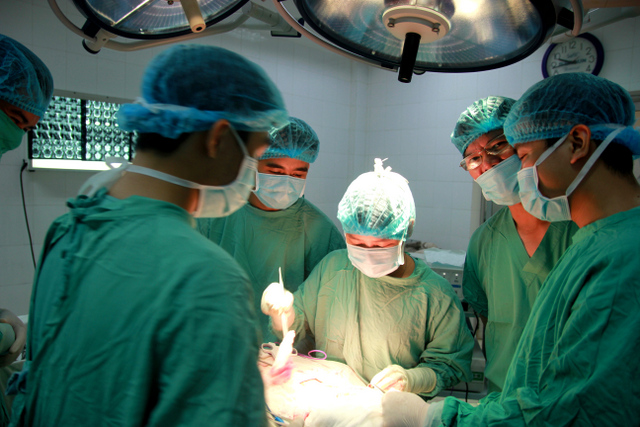|
Initial application of Ligasure in Head and Neck Surgery
(06-05-2020 15:09)
Head and Neck surgery is relatively complicated, involving many important anatomical landmarks such as cranial nerves and large vessels. Bleeding control is one of the main goals during dissection. The application of Ligasure vessel sealing system in head and neck surgery was reported to be reliable and safe in several studies. Ligasure is able to achieve good hemostasis, reduce operation time, relieve post-operative pain, and recover quickly after surgery. This device was developed as an alternative to ligatures, hemoclips, staplers, and ultrasonic coagulators for ligating vessels and tissue bundles. When Ligasure clamps into the tissue bundle, it creates intracellular friction, disrupts Hydrogen Bridge, denatures proteins, and performs coagulation. Despite the high degree of heat produced between the jaws of the instrument, it does not produce a large amount of lateral heat. It also reduces the smoke production and adhesions, then damage to surrounding tissues is low.
A couple of cases performed surgical procedures with use of Ligasure
Case 1: Neck dissection in patient with cancer of tonsil
A 64-year-old female presented to our department of Otolaryngology, Hue University of Medicine and Pharmacy Hospital with dysphagia and a right-sided palpable cervical mass. She has no specific medical history. The operative time was under one hour. Total postoperative neck drainage was less than 20ml. She was removed from 5.l-hemovac drainage on the second postop day. Her status was stable.
Case 2: Superficial parotidectomy with preservation of facial nerve
A 58-year-old male patient presented to the ENT Department, Hue University of Medicine and Pharmacy Hospital with a two-year gradually palpable mass at the left angle of mandibular. He has 20-year history of smoking. He underwent a surgery for superficial parotidectomy with facial nerve preservation. Permanent biopsied findings showed enlarged salivary glands and reactive proliferative lymph nodes with no malignant tissue. Postoperative findings noted no facial palsy; neck drainage was removed on the second postop day with < 5ml amount of fluid. He was discharged on the seventh postop day.
Case 3: Thyroidectomy with recurrent laryngeal nerve and parathyroid glands
A 53-year-old female was admitted to the hospital with a discomfort feeling on anterior neck which leads to mild dyspnea and dysphagia. Neck sonography showed a cystic mass measuring 50 x 90 mm in diameter on the left lobe of thyroid gland. She had performed left thyroid lobectomy and preserved recurrent laryngeal nerve and parathyroid glands with the use of Ligasure. The operative time was less than 30 minutes. Preliminary postop assessments were no hoarseness, no hematoma, mild postop pain, and good recovery after surgery.
A 37-year-old man presented to the hospital with a mass on the right-sided thyroid gland measuring 15x11x18mm in diameter. Sonography and cervical computer tomography revealed no neck metastasis. He underwent right lobectomy and isthmusectomy. Histological findings revealed well-differential papillary carcinoma. Postop status was no hoarseness, no hematoma, no postop pain.
Through the case summarized above, in the initial application of Ligasure in head and neck surgery, it is noted that Ligasure is a reliable, safe, and power device. This is an advance in the field of head and neck surgery which needs to be widely applied.
Dr. Phan Huu Ngoc Minh (Ph.D.) Department of Otolaryngology, University of Medicine and Pharmacy, Hue University
Newer News
 Building human resource meets the demand of the Information Technology (IT) development of Thua Thien Hue Province
(12-06-2020 17:30)
Building human resource meets the demand of the Information Technology (IT) development of Thua Thien Hue Province
(12-06-2020 17:30)
 President of Hue University welcomes the Ambassador of the Kingdom of Belgium to Vietnam
(10-06-2020 16:02)
President of Hue University welcomes the Ambassador of the Kingdom of Belgium to Vietnam
(10-06-2020 16:02)
 Creating a 4D database for tourism development in Ly Son district, Quang Ngai province
(03-06-2020 11:04)
Creating a 4D database for tourism development in Ly Son district, Quang Ngai province
(03-06-2020 11:04)
 Making cooperative plans between scientific research and technology transfer in the fields of Agriculture, Forestry and Fisheries in Thua Thien Hue province
(22-05-2020 08:29)
Making cooperative plans between scientific research and technology transfer in the fields of Agriculture, Forestry and Fisheries in Thua Thien Hue province
(22-05-2020 08:29)
 Hue University leaders hold a flower offering ceremony to commemorate President Ho Chi Minh's 130th birthday (19-05-2020 08:59)
(20-05-2020 16:55)
Hue University leaders hold a flower offering ceremony to commemorate President Ho Chi Minh's 130th birthday (19-05-2020 08:59)
(20-05-2020 16:55)
 Seminar on the celebration of Vietnam Science and Technology Day (18-05-2020 16:53)
(20-05-2020 16:52)
Seminar on the celebration of Vietnam Science and Technology Day (18-05-2020 16:53)
(20-05-2020 16:52)
 Scientific Workshop on Hue - Hanoi - Saigon towards the heritage journey and national security (18-05-2020 18:17)
(20-05-2020 16:38)
Scientific Workshop on Hue - Hanoi - Saigon towards the heritage journey and national security (18-05-2020 18:17)
(20-05-2020 16:38)
Older News
 Predoctoral training program to prepare for qualified candidates who apply for the doctoral program
(16-04-2020 08:20)
Predoctoral training program to prepare for qualified candidates who apply for the doctoral program
(16-04-2020 08:20)
 Hue University School of Tourism and Hospitality provides high quality human resources in tourism
(10-04-2020 17:24)
Hue University School of Tourism and Hospitality provides high quality human resources in tourism
(10-04-2020 17:24)
|
News
Last News
Web link
|





